Xiaoyu Liang
OpenRoboCare: A Multimodal Multi-Task Expert Demonstration Dataset for Robot Caregiving
Nov 17, 2025Abstract:We present OpenRoboCare, a multimodal dataset for robot caregiving, capturing expert occupational therapist demonstrations of Activities of Daily Living (ADLs). Caregiving tasks involve complex physical human-robot interactions, requiring precise perception under occlusions, safe physical contact, and long-horizon planning. While recent advances in robot learning from demonstrations have shown promise, there is a lack of a large-scale, diverse, and expert-driven dataset that captures real-world caregiving routines. To address this gap, we collect data from 21 occupational therapists performing 15 ADL tasks on two manikins. The dataset spans five modalities: RGB-D video, pose tracking, eye-gaze tracking, task and action annotations, and tactile sensing, providing rich multimodal insights into caregiver movement, attention, force application, and task execution strategies. We further analyze expert caregiving principles and strategies, offering insights to improve robot efficiency and task feasibility. Additionally, our evaluations demonstrate that OpenRoboCare presents challenges for state-of-the-art robot perception and human activity recognition methods, both critical for developing safe and adaptive assistive robots, highlighting the value of our contribution. See our website for additional visualizations: https://emprise.cs.cornell.edu/robo-care/.
SAGE: Semantic-Aware Shared Sampling for Efficient Diffusion
Sep 19, 2025Abstract:Diffusion models manifest evident benefits across diverse domains, yet their high sampling cost, requiring dozens of sequential model evaluations, remains a major limitation. Prior efforts mainly accelerate sampling via optimized solvers or distillation, which treat each query independently. In contrast, we reduce total number of steps by sharing early-stage sampling across semantically similar queries. To enable such efficiency gains without sacrificing quality, we propose SAGE, a semantic-aware shared sampling framework that integrates a shared sampling scheme for efficiency and a tailored training strategy for quality preservation. Extensive experiments show that SAGE reduces sampling cost by 25.5%, while improving generation quality with 5.0% lower FID, 5.4% higher CLIP, and 160% higher diversity over baselines.
Content-Rich AIGC Video Quality Assessment via Intricate Text Alignment and Motion-Aware Consistency
Feb 06, 2025
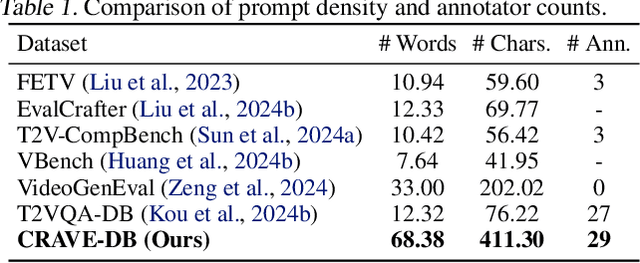
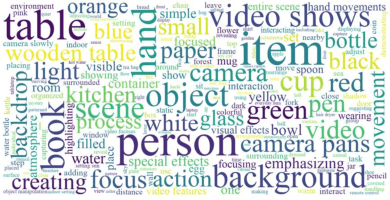
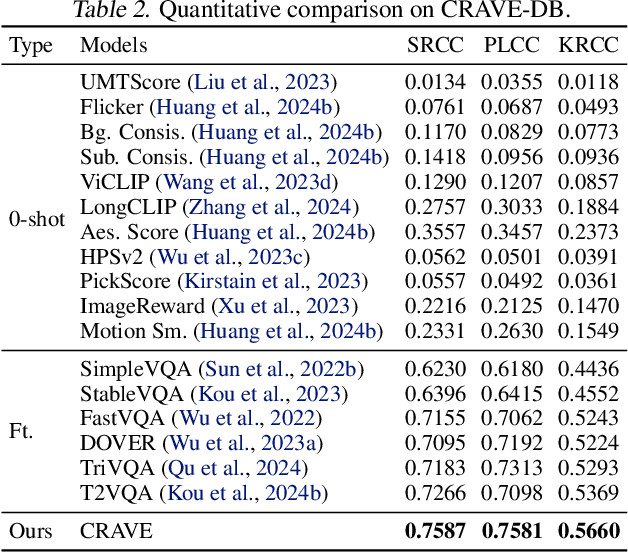
Abstract:The advent of next-generation video generation models like \textit{Sora} poses challenges for AI-generated content (AIGC) video quality assessment (VQA). These models substantially mitigate flickering artifacts prevalent in prior models, enable longer and complex text prompts and generate longer videos with intricate, diverse motion patterns. Conventional VQA methods designed for simple text and basic motion patterns struggle to evaluate these content-rich videos. To this end, we propose \textbf{CRAVE} (\underline{C}ontent-\underline{R}ich \underline{A}IGC \underline{V}ideo \underline{E}valuator), specifically for the evaluation of Sora-era AIGC videos. CRAVE proposes the multi-granularity text-temporal fusion that aligns long-form complex textual semantics with video dynamics. Additionally, CRAVE leverages the hybrid motion-fidelity modeling to assess temporal artifacts. Furthermore, given the straightforward prompts and content in current AIGC VQA datasets, we introduce \textbf{CRAVE-DB}, a benchmark featuring content-rich videos from next-generation models paired with elaborate prompts. Extensive experiments have shown that the proposed CRAVE achieves excellent results on multiple AIGC VQA benchmarks, demonstrating a high degree of alignment with human perception. All data and code will be publicly available at https://github.com/littlespray/CRAVE.
Dynamic Token Reduction during Generation for Vision Language Models
Jan 24, 2025Abstract:Vision-Language Models (VLMs) have achieved notable success in multimodal tasks but face practical limitations due to the quadratic complexity of decoder attention mechanisms and autoregressive generation. Existing methods like FASTV and VTW have achieved notable results in reducing redundant visual tokens, but these approaches focus on pruning tokens in a single forward pass without systematically analyzing the redundancy of visual tokens throughout the entire generation process. In this paper, we introduce a dynamic pruning strategy tailored for VLMs, namedDynamic Rate (DyRate), which progressively adjusts the compression rate during generation. Our analysis of the distribution of attention reveals that the importance of visual tokens decreases throughout the generation process, inspiring us to adopt a more aggressive compression rate. By integrating a lightweight predictor based on attention distribution, our approach enables flexible adjustment of pruning rates based on the attention distribution. Our experimental results demonstrate that our method not only reduces computational demands but also maintains the quality of responses.
Enhancing Facial Consistency in Conditional Video Generation via Facial Landmark Transformation
Dec 12, 2024

Abstract:Landmark-guided character animation generation is an important field. Generating character animations with facial features consistent with a reference image remains a significant challenge in conditional video generation, especially involving complex motions like dancing. Existing methods often fail to maintain facial feature consistency due to mismatches between the facial landmarks extracted from source videos and the target facial features in the reference image. To address this problem, we propose a facial landmark transformation method based on the 3D Morphable Model (3DMM). We obtain transformed landmarks that align with the target facial features by reconstructing 3D faces from the source landmarks and adjusting the 3DMM parameters to match the reference image. Our method improves the facial consistency between the generated videos and the reference images, effectively improving the facial feature mismatch problem.
KnowledgeSG: Privacy-Preserving Synthetic Text Generation with Knowledge Distillation from Server
Oct 10, 2024



Abstract:The success of large language models (LLMs) facilitate many parties to fine-tune LLMs on their own private data. However, this practice raises privacy concerns due to the memorization of LLMs. Existing solutions, such as utilizing synthetic data for substitution, struggle to simultaneously improve performance and preserve privacy. They either rely on a local model for generation, resulting in a performance decline, or take advantage of APIs, directly exposing the data to API servers. To address this issue, we propose KnowledgeSG, a novel client-server framework which enhances synthetic data quality and improves model performance while ensuring privacy. We achieve this by learning local knowledge from the private data with differential privacy (DP) and distilling professional knowledge from the server. Additionally, inspired by federated learning, we transmit models rather than data between the client and server to prevent privacy leakage. Extensive experiments in medical and financial domains demonstrate the effectiveness of KnowledgeSG. Our code is now publicly available at https://github.com/wwh0411/KnowledgeSG.
E-Bench: Subjective-Aligned Benchmark Suite for Text-Driven Video Editing Quality Assessment
Aug 21, 2024Abstract:Text-driven video editing has recently experienced rapid development. Despite this, evaluating edited videos remains a considerable challenge. Current metrics tend to fail to align with human perceptions, and effective quantitative metrics for video editing are still notably absent. To address this, we introduce E-Bench, a benchmark suite tailored to the assessment of text-driven video editing. This suite includes E-Bench DB, a video quality assessment (VQA) database for video editing. E-Bench DB encompasses a diverse set of source videos featuring various motions and subjects, along with multiple distinct editing prompts, editing results from 8 different models, and the corresponding Mean Opinion Scores (MOS) from 24 human annotators. Based on E-Bench DB, we further propose E-Bench QA, a quantitative human-aligned measurement for the text-driven video editing task. In addition to the aesthetic, distortion, and other visual quality indicators that traditional VQA methods emphasize, E-Bench QA focuses on the text-video alignment and the relevance modeling between source and edited videos. It proposes a new assessment network for video editing that attains superior performance in alignment with human preferences. To the best of our knowledge, E-Bench introduces the first quality assessment dataset for video editing and an effective subjective-aligned quantitative metric for this domain. All data and code will be publicly available at https://github.com/littlespray/E-Bench.
FALIP: Visual Prompt as Foveal Attention Boosts CLIP Zero-Shot Performance
Jul 08, 2024



Abstract:CLIP has achieved impressive zero-shot performance after pre-training on a large-scale dataset consisting of paired image-text data. Previous works have utilized CLIP by incorporating manually designed visual prompts like colored circles and blur masks into the images to guide the model's attention, showing enhanced zero-shot performance in downstream tasks. Although these methods have achieved promising results, they inevitably alter the original information of the images, which can lead to failure in specific tasks. We propose a train-free method Foveal-Attention CLIP (FALIP), which adjusts the CLIP's attention by inserting foveal attention masks into the multi-head self-attention module. We demonstrate FALIP effectively boosts CLIP zero-shot performance in tasks such as referring expressions comprehension, image classification, and 3D point cloud recognition. Experimental results further show that FALIP outperforms existing methods on most metrics and can augment current methods to enhance their performance.
CushSense: Soft, Stretchable, and Comfortable Tactile-Sensing Skin for Physical Human-Robot Interaction
May 06, 2024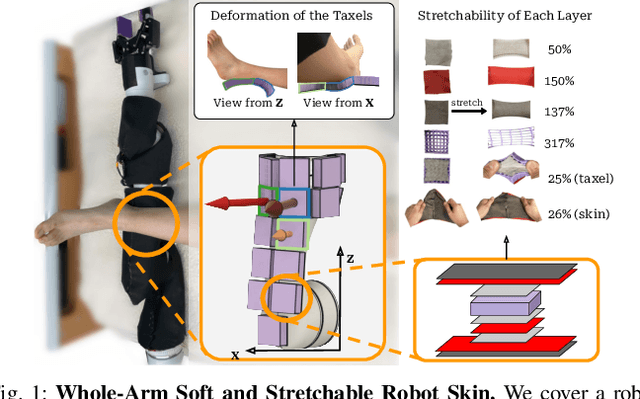

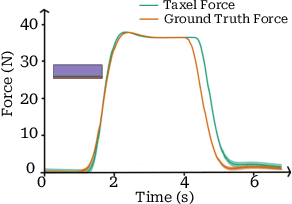
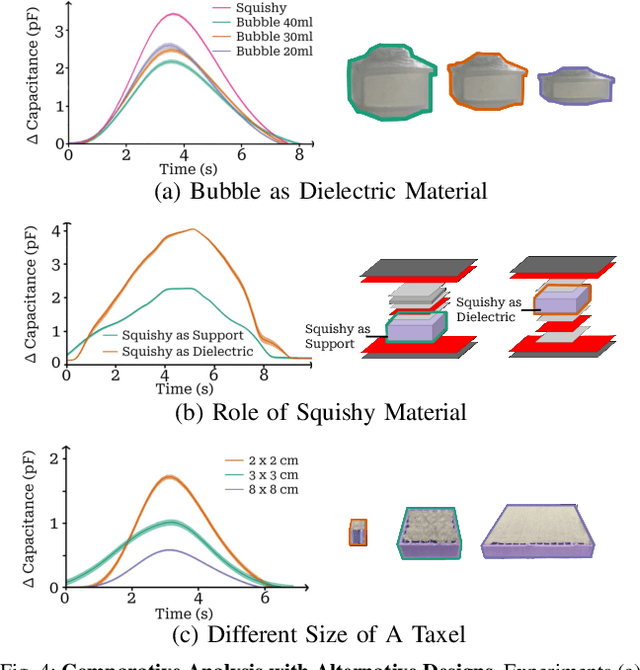
Abstract:Whole-arm tactile feedback is crucial for robots to ensure safe physical interaction with their surroundings. This paper introduces CushSense, a fabric-based soft and stretchable tactile-sensing skin designed for physical human-robot interaction (pHRI) tasks such as robotic caregiving. Using stretchable fabric and hyper-elastic polymer, CushSense identifies contacts by monitoring capacitive changes due to skin deformation. CushSense is cost-effective ($\sim$US\$7 per taxel) and easy to fabricate. We detail the sensor design and fabrication process and perform characterization, highlighting its high sensing accuracy (relative error of 0.58%) and durability (0.054% accuracy drop after 1000 interactions). We also present a user study underscoring its perceived safety and comfort for the assistive task of limb manipulation. We open source all sensor-related resources on https://emprise.cs.cornell.edu/cushsense.
Exploring AIGC Video Quality: A Focus on Visual Harmony, Video-Text Consistency and Domain Distribution Gap
Apr 27, 2024Abstract:The recent advancements in Text-to-Video Artificial Intelligence Generated Content (AIGC) have been remarkable. Compared with traditional videos, the assessment of AIGC videos encounters various challenges: visual inconsistency that defy common sense, discrepancies between content and the textual prompt, and distribution gap between various generative models, etc. Target at these challenges, in this work, we categorize the assessment of AIGC video quality into three dimensions: visual harmony, video-text consistency, and domain distribution gap. For each dimension, we design specific modules to provide a comprehensive quality assessment of AIGC videos. Furthermore, our research identifies significant variations in visual quality, fluidity, and style among videos generated by different text-to-video models. Predicting the source generative model can make the AIGC video features more discriminative, which enhances the quality assessment performance. The proposed method was used in the third-place winner of the NTIRE 2024 Quality Assessment for AI-Generated Content - Track 2 Video, demonstrating its effectiveness. Code will be available at https://github.com/Coobiw/TriVQA.
 Add to Chrome
Add to Chrome Add to Firefox
Add to Firefox Add to Edge
Add to Edge